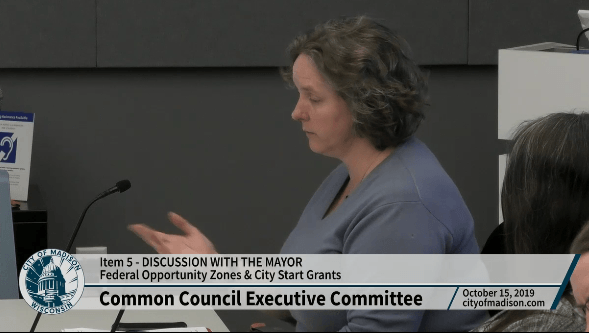The mayor explains at the Common Council Executive Committee (CCEC) meeting, after the fact.
I blogged about a meeting that wasn’t publicly noticed the other day where federal government staff were here to schmooze with business community leaders, the mayor and who knows who else. Here’s the mayor’s explanation of that encounter at the CCEC meeting yesterday.
GETTING STARTED
You can follow along with the meeting here if you are interested.
They start late. Looks like alders present include Shiva Bidar, Barbara Harrington-McKinney, Tag Evers, Sherry Carter, Grant Foster are there, Martin is excused, Kemble and Baldeh are absent. Keith Furman joins them, but not a committee member. They approve their minutes without discussion. There is no public comment except for one registration on item 8. There are no disclosures and recusals.
DISCUSSION WITH THE MAYOR
Opportunity Zones
Mayor Satya Rhodes-Conway joins them. She reports that they had a visit from the federal government including the Chair of the White House Council on Opportunity “and something” which is the body that is working on Opportunity Zones at the federal level. They also had representatives from the Small Business Administration, the Economic Development Administration, USDA and EPA. Scott Turner is the chair of the council and has been traveling around the country talking to municipalities talking about opportunity zones and when she was in D.C. they suggested he come to Madison. He was in Wis. anyways, he is in Marionette today. They did a day long meeting with other elected leaders with the Mayors of Sun Prairie, Fitchburg and Monona, their staff and various city staff to frame where the opportunity zones are in Madison and what we are doing already and what is our long-term planning around economic development and land use in those areas. They they had a group of community leaders come in and talk about the priorities and experiences. Then they did a bus tour of 10 of the 11 opportunity zones in Madison. The reason all this happens is because there are two benefits. It’s set up to be a place where people who have capital gains can park them in development in these geographies and it is designed to turn capital gains into moderately patient capital for projects in opportunity zones. These would be privately run developments, new buildings and other business investments. One project is a Stone House Affordable Housing project that is using Opportunity Zone funding. (Looks like Rebecca Kemble and Patrick Heck have joined) The other way the federal government and council is pushing on is that they identified over 100 different sources of federal money that if the project proposed is in an opportunity zone your proposal gets preference or bonus points. One of those is the 5339B bus and bus facilities grant which we have applied for, but there are many others from several agencies. So we are focusing in on where our opportunity zones are in Madison, what we might want to do and what federal funds we might apply for and that is worthy paying attention to. Mostly this was an, “here we are” and “you should want to invest in us federal government”, but it was also relationship building and hopefully when future asks cross desks it will bear fruit. She wanted people to know that happened but its not clear what the next steps are, but at least communication would happen.
Tag Evers asks if there was any discussions about the downsides of these zones? Anthony Scaramucci and others are big fans of these. What can we do to make sure that the folks investing in our cities and these areas are mission focused. Mayor says they can’t do anything, but they can do all of their regular development process to make sure that we get good projects. The city has no jurisdiction over investment in private projects, so there is no control we have there. But we do have considerable land use control.
Evers asks if there was recognition that it has been abused in some ways? Mayor says yes. “Absolutely, it did come up several times.” In fact there were a number of concerns raised from the folks from the development community in the room about how hard it is to include opportunities zones funding in their capital stack. And how it doesn’t fit well with other state and federal funding programs. They talked about the unintended consequences of investment in these areas and not to just see additional displacement as a result. They talked a lot about the downsides. She is “personally skeptical about the program”, she adds “or maybe that’s not the right way to say that” but given how it started there are pluses and minuses. She thinks that on the federal grant side to the extent that we can get preference that is a positive thing.




